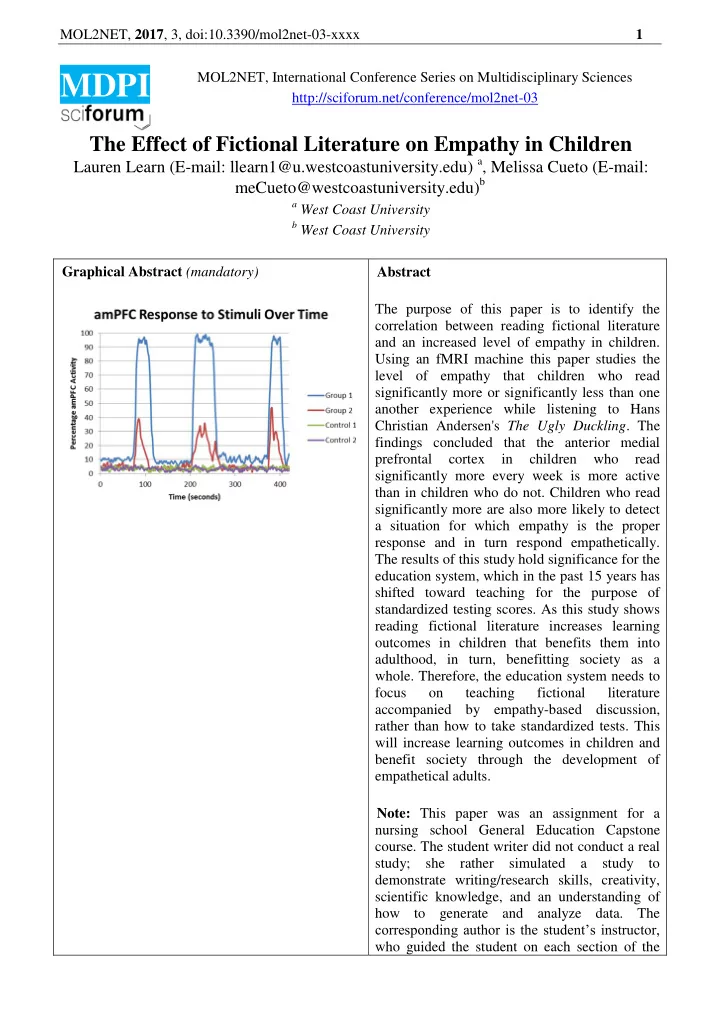

MOL2NET, 2017 , 3, doi:10.3390/mol2net-03-xxxx 1 MOL2NET, International Conference Series on Multidisciplinary Sciences MDPI http://sciforum.net/conference/mol2net-03 The Effect of Fictional Literature on Empathy in Children Lauren Learn (E-mail: llearn1@u.westcoastuniversity.edu) a , Melissa Cueto (E-mail: meCueto@westcoastuniversity.edu) b a West Coast University b West Coast University Graphical Abstract (mandatory) Abstract The purpose of this paper is to identify the correlation between reading fictional literature and an increased level of empathy in children. Using an fMRI machine this paper studies the level of empathy that children who read significantly more or significantly less than one another experience while listening to Hans Christian Andersen's The Ugly Duckling . The findings concluded that the anterior medial prefrontal cortex in children who read significantly more every week is more active than in children who do not. Children who read significantly more are also more likely to detect a situation for which empathy is the proper response and in turn respond empathetically. The results of this study hold significance for the education system, which in the past 15 years has shifted toward teaching for the purpose of standardized testing scores. As this study shows reading fictional literature increases learning outcomes in children that benefits them into adulthood, in turn, benefitting society as a whole. Therefore, the education system needs to focus on teaching fictional literature accompanied by empathy-based discussion, rather than how to take standardized tests. This will increase learning outcomes in children and benefit society through the development of empathetical adults. Note: This paper was an assignment for a nursing school General Education Capstone course. The student writer did not conduct a real study; she rather simulated a study to demonstrate writing/research skills, creativity, scientific knowledge, and an understanding of how to generate and analyze data. The corresponding author is the student’s instructor, who guided the student on each section of the
MOL2NET, 2017 , 3, doi:10.3390/mol2net-03-xxxx 2 scientific paper, providing feedback on how to “conduct” the study and on how to revise the writing. Introduction Literature Review: Scientific Empathy is a multidimensional concept found in humans that allows them to cognitively participate in other people's feelings or processes of their mind (Butler, Carlin, & Nickerson, 2009). Empathy develops throughout childhood and, as outlined by Hoffman (1984), progresses through four distinct developmental stages. The first stage is infancy, in which infants do not have the capacity to distinguish themselves from others. Hoffman says, that while infants are not yet developmentally mature enough to empathize, hearing another infant cry will induce crying. The ability to empathize is innate and therefore, precursors such as this can be seen throughout life. The second developmental phase that Hoffman discusses forms when the child is able to recognize him or herself as physically different from others. From ages two to three, children learn that other people also experience feelings that are distinct from their own. As they develop the ability to speak and experience higher cognition thoughts, children also develop the ability to empathize with people who are not present; this is known as perspective taking (Hoffman, 1984). The last level of empathetic development occurs in late childhood, at which point children are able to empathize with people who are not present or who they do not know about ongoing problems (Cress 1998). Society refers to people who do not develop empathy as psychopaths. According to Anderson and Kiehl (2011) due to their lack of empathy psychopaths commit a disproportionate amount of violent crimes that create significant emotional and financial burden on society. Aharon-Peretz, Harari, Levkovitz, and Shamay-Tsoory (2010) theorize that an impairment in the emotional aspect of theory of mind in psychopaths' accounts for their impaired social behavior. Aharon-Peretz, et al. hypothesize that the manifestation of a deficient emotional theory of mind is associated with a dysfunctional orbitofrontal cortex (OFC). In order to test this hypothesis, they compared the theory of mind abilities of criminal offenders who were diagnosed with antisocial personality disorder and high psychopathy features to subjects with localized OFC lesions. The results of this study showed that subjects with psychopathy and those with frontal lobe, specifically OFC, lesions were both impaired in their emotional theory of mind abilities (Aharon- Peretz, et al., 2010). This shows that there is a distinct correlation between brain dysfunction and the lack of empathy that is found in psychopaths. Anderson and Kiehl (2010) also concluded that there is a set of brain regions that are consistently found in correlation to psychopathy. These regions include the OFC, amygdala, and anterior cingulate and ad acent limbic structures (Anderson & Keihl, 2010). Using technology such as functional magnetic resonance imaging (fMRI), scientists are able to examine the neurological mechanisms behind empathetic responses, giving people further insight into the development and formation of empathy. A study by Nijhof and Willems (2015) localized the cortical motor network and mentalizing network using neuroimaging. Their goal was to examine the response of both networks during an empathetic stimulus. The stimulus used in this study was fictional literature, which has historically been linked to a mentalizing response by the brain. Mentalizing is the brain's ability to understand the thoughts, feelings, and intent of others, i.e. empathy (Nijhof & Willems, 2015). A study by Wallentin and colleagues, that observed both sensori-motor stimulation and mentalizing during the reading of "The Ugly Duckling", found that the visual cortex, for observing visual stimulus, and the section of the brain related to mentalizing were both activated (Nijhof & Willems, 2015). This indicates that not only do people hear literature and mentalize it verbally but they also "experience" it in their minds, indicated by the activation of the visual cortex while performing a verbal activity (Nijhof & Willems, 2015). Therefore, fictional literature can create a scenario that readers experience in a similar way to a scenario they visually observe. Nijhof and Willems' study found that there was a significant response by the anterior medial prefrontal cortex (amPFC) in
Recommend
More recommend